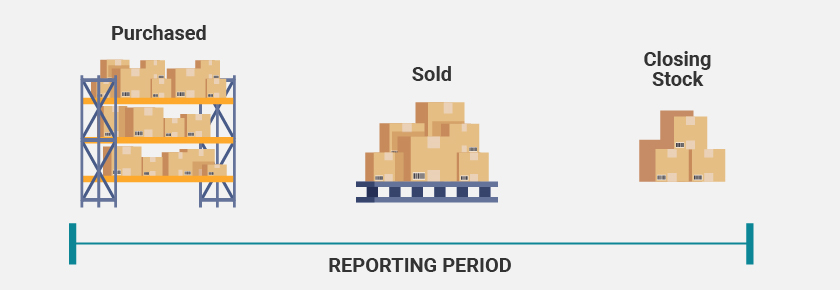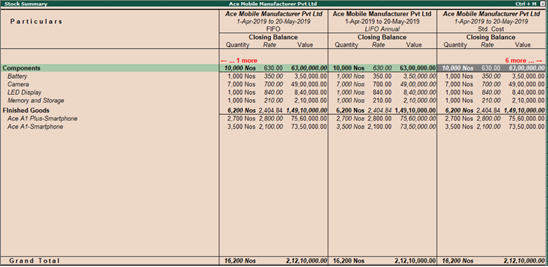- What is inventory valuation?
- Why do we need stock valuation?
- How to value stock?
- Inventory valuation methods with examples
- How do businesses calculate closing stock value?
Inventories are usually the largest current asset of a business and it holds huge working capital of the business. The way you manage the inventory has a direct impact on the profitability and the financials of the business. One of the key aspects associated with managing stock is inventory valuation.
If the inventories are not properly measured, expenses and revenues cannot be properly matched, and a company could make poor business decisions.
Let’s deep dive to understand the need for inventory valuation, methods and how to calculate with an example.
What is inventory valuation?
Inventory valuation is a process to determine the cost associated with an entity's inventory at the end of a reporting period. To simplify, it is all about driving the value of the stock which are unsold for a given period, usually on the date of preparing financial statements.

No matter what type of inventory you hold – Raw materials, WIP goods or Finished goods, all of these should be valued at the end of the reporting period. You will be in a position to know the business profitability only when you to determine the cost of goods by way of stock valuation.
Inventory valuation is carried out considering the valuation guidelines and methods as prescribed in the accounting standard.
Want to know more about closing Stock? Read ‘ What is closing Stock? Examples and Calculations?
Before we dive into inventory valuation methods, let us understand the reasons why business value stock?
Why do we need stock valuation?
- To determine the current value of the unsold stock
- Derive the cost of goods sold
- To know the accurate profitability
- The stock statement with values is one of the important collaterals for getting approval for bank loans.
- Helps in the projection of future revenues and aids in business decisions.
How to value stock?
In arriving the value of a stock, there are different methods as prescribed in accounting standards using which the stock is valued.
Based on the company’s requirement, any of the valuation methods can be used in determining the closing stock value. Inventory valuation is popularly known as stock valuation or costing method.
Inventory valuation methods with examples
Average costing method
Under the average costing method, the average price is used to calculate the closing value of stock-in-hand. This method consists of a weighted average costing method and moving average method.
Among these 2 methods, the weighted average method is most commonly used.
Let’s understand it with an example.
Under the weighted average costing method, the closing values are calculated by deriving an average rate considering all the inward values of a stock item. The formula to calculate the weighted average is as below:

Examples of weighted average inventory valuation
The purchases and sales details of Max Enterprises for the month of April is given below:
|
Date |
Particulars |
Qty |
Rate |
Value |
|
01/04/2019 |
Purchase |
10 Nos |
100 |
1000 |
|
02/04/2019 |
Purchase |
05 Nos |
250 |
1250 |
|
3/04/2019 |
Sales |
10 Nos |
500 |
5000 |
In the above example, the closing quantity at the end of April is 5 Nos (Inward -outward) and to arrive the closing value, you need to apply the weighted average formula.

Once the weighted average price is calculated, it continues to be the basis for costing until a new weighted average is computed. A new weighted average cost is computed, not at every time of issue, but only when a new lot is purchased at a different rate.
FIFO – first in first out
FIFO methods work on the assumption that the stock items which are produced or purchased first will be issued or sold first. Thus, the closing value is arrived by considering the closing stock value in each inward batch.

Example of FIFO Inventory Valuation
Purchase and sales details for the month of April are given below:
|
Date |
Particulars |
Qty |
Rate |
Amount |
|
1/04/2019 |
Purchase |
100 Nos |
100 |
10,000/- |
|
02/04/2019 |
Purchase |
100 Nos |
150 |
15,000/- |
|
5/4/2019 |
Sales |
100 Nos |
200 |
20,000/- |
Here, the closing value of is 15,000/- for 100 qty @ 150/ Nos. How?
The closing stock of 100 Nos is from the latest inward batch of 2nd April 2019 at a cost price of 150/Nos. Applying the FIFO definition, the inventories will always be issued from the old inward batch i.e. purchases made on 1st April and closing stock will always be from the latest batch which is 2nd April.
LIFO - last in first out
Under LIFO, the stocks which are bought latest are issued first and closing value is arrived by considering the closing stock value in each inwards batch. This is exactly opposite to FIFO method.

Example of LIFO inventory valuation
Purchase and sales details for the month of April are given below:
|
Date |
Particulars |
Qty |
Rate |
Amount |
|
1/04/2019 |
Purchase |
100 Nos |
100 |
10,000/- |
|
02/04/2019 |
Purchase |
100 Nos |
150 |
15,000/- |
|
5/4/2019 |
Sales |
100 Nos |
200 |
20,000/- |
Here, the closing value of is 10,000/- for 100 qty @ 100/ Nos.
The closing stock of 100 Nos is from the oldest inward batch of 1st April 2019 at a cost price of 100/Nos. Applying the LIFO definition, inventories will be first issued from the newest inward batch i.e. purchases made on 2nd April and closing stock will always be from the oldest batch which is 1st April.
Standard costing
Using Standard costing, the closing stock will be valued at a predetermined cost irrespective of the inwards costs. This is method is also known as the ‘User Defined’ method because business can specify its own rate for valuing of the inventories.
Example of standard costing inventory valuation
The purchase and sales details are given below:
|
Date |
Particulars |
Qty |
Rate |
Value |
|
01/04/2019 |
Purchase |
10 |
2,500 |
25,000 |
|
02/04/2019 |
Purchase |
20 |
2,450 |
49,000 |
|
03/04/2019 |
Purchase |
30 |
2,550 |
76,500 |
|
04/04/2019 |
Sales |
15 |
3,000 |
7500 |
The standard cost of stock Item is 2500/- Nos
The closing value of stock will be 1,12,500 for 45 Nos @ 2500/nos. Even though different inward rates exist, the closing value will be valued at Rs. 2500/- (Std rate)
Last purchase cost
Under this method, inventories will be valued based on last purchase cost as the reference point for calculating the stock value. This costing method is suitable when you to value the closing balance based on the latest cost.
Examples of last purchase cost
|
Date |
Particulars |
Qty |
Rate |
Amount |
|
1/04/2019 |
Purchase |
100 Nos |
100 |
10,000/- |
|
02/04/2019 |
Purchase |
100 Nos |
150 |
15,000/- |
|
5/4/2019 |
Sales |
100 Nos |
200 |
20,000/- |
The closing value will be 15,000/- for 100 Nos (last purchase cost 150/Nos * closing quantity 100 Nos)
At zero cost
Under this costing method, the value of stock items will always be ‘Zero’, irrespective of the cost incurred. This method is suitable only when quantities need to be tracked but not the value like in the case of consumables, sub-contracting business etc.
How do businesses calculate closing stock value?
Often inventory is called ‘Necessary Evil’ due to the complexities associated in managing and measuring it. Stock valuation is the core of it. This stayed true until the business started using the TallyPrime software or Accounting software with a built-in inventory management system. The ease of accounting inventories, real-time update of closing stock, auto-populated reports etc. has increased the efficiency of the business and more importantly, managing and measuring inventory.
On the other side, the traditional way of calculating the closing stock manually risks the accuracy of the values calculated. If the inventory is not properly measured, expenses and revenues cannot be properly matched, and a company could make poor business decisions.

Closing Stock Value Comparison with Different Stock Valuation Methods in Tally.ERP 9.
Using TallyPrime, you can set different inventory valuation method for different stock items and it allows you a quick comparison of stock value with different valuation methods. All of these in a few clicks!. Know more about TallyPrime's features.
Read More on Inventory Management
Inventory Management, Inventory Management Software, Inventory Management Techniques, Inventory Reports, Inventory Planning, Inventory Control, Inventory Turnover Ratio, Importance & Benefits of Inventory Management, How to Audit Inventory, What is a Barcode, What is Physical Stock Voucher, Stock Query and Its Benefits, How Godown Summary Helps in Better Inventory Management, What is Stock-Item Wise Profitability

















